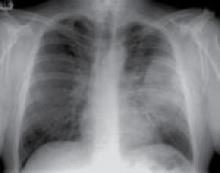When the patient has 2 or more of the following CURB-65 criteria: respiratory rate ≥30, acute confusion, low blood pressure (systolic blood pressure <90 or diastolic BP ≤60 mm Hg), blood urea nitrogen [BUN] >19.6 mg/dL, and age ≥65 years (strength of recommendation [SOR]: B, based on 3 prospective cohort studies). Alternatively, consider hospitalization for patients presenting with a Pneumonia Severity Index (PSI) class of 4 or 5 (SOR: B; 1 prospective cohort study). There are no studies that test whether using these rules improve outcomes over standard care.
What about the homeless man, or the debilitated woman?
Timothy E. Huber, MD
Oroville, Calif
I occasionally work in my community hospital’s emergency room. Clinical decision rules are often very helpful, but they are limited when dealing with special populations, such as patients who are immunosuppressed or pregnant, or those with underlying cardiac or lung disease.
In addition, there are often social factors that must be taken into account when considering admitting a patient. For instance, a homeless man may not be able to purchase his medications; a debilitated woman living alone may not be able to adequately care for herself, despite a low CURB-65 score. Clinical decision rules provide a useful starting point, but they are meant to supplement, not replace, clinical decision-making.
Evidence summary
The CURB-65 criteria: Having ≥2 factors increases mortality
In a split-sample (derivation and validation) analysis1 of 3 prospective studies involving 1068 patients presenting to the hospital with the diagnosis of pneumonia, various clinical features were analyzed for their association with 30-day mortality. The 5 parameters that were most strongly associated with mortality were:
- acute confusion (odds ratio [OR]=8.1; 95% confidence interval [CI], 4.8–13.7)
- BUN >19.6 mg/dL (OR= 5.6; 95% CI, 3.1–10)
- respiratory rate ≥30 (OR=1.7; 95% CI, 1.07–2.8)
- low blood pressure (SBP <90 or DBP ≤60) (OR=2.4; 95% CI, 1.4–3.8)
- age ≥65 years (OR=5.5; 95% CI, 2.8–10.9).
The 30-day mortality estimation using these 5 criteria is called CURB-65 (Confusion, Urea, Respiratory rate, low Blood pressure, and age ≥65).
In patients with 2 or more of these factors, the associated rate of mortality increased significantly compared with patients who had none or only 1 of the factors (TABLE 1). Although albumin <3.0 g/dL was also significantly associated with an increased mortality rate (OR=4.7; 95% CI, 2.5–8.7), it was not included in CURB-65 because it is not a routine lab ordered for patients with pneumonia.
A variation of the CURB-65 score, CRB-65, uses only the clinical parameters without laboratory data (confusion, respiratory rate, blood pressure, and age). Patients with a score of 0 had a 0.9% 30-day mortality rate. However, the rate increased to 8.15% when patients had 1 or 2 of the 4 clinical criteria.
TABLE 1
CURB-65 criteria
Give 1 point for each:
|
| |
| SCORE | 30-DAY MORTALITY | POSSIBLE TREATMENT OPTIONS |
| 0 or 1 | Low (1.5%) | Consider outpatient treatment |
| 2 | Intermediate (9.2%) | Short-stay hospitalization or closely monitored outpatient therapy |
| 3 or more | High (22%) | Hospitalize and consider ICU |
| Source: Lim et al 2003.1 | ||


